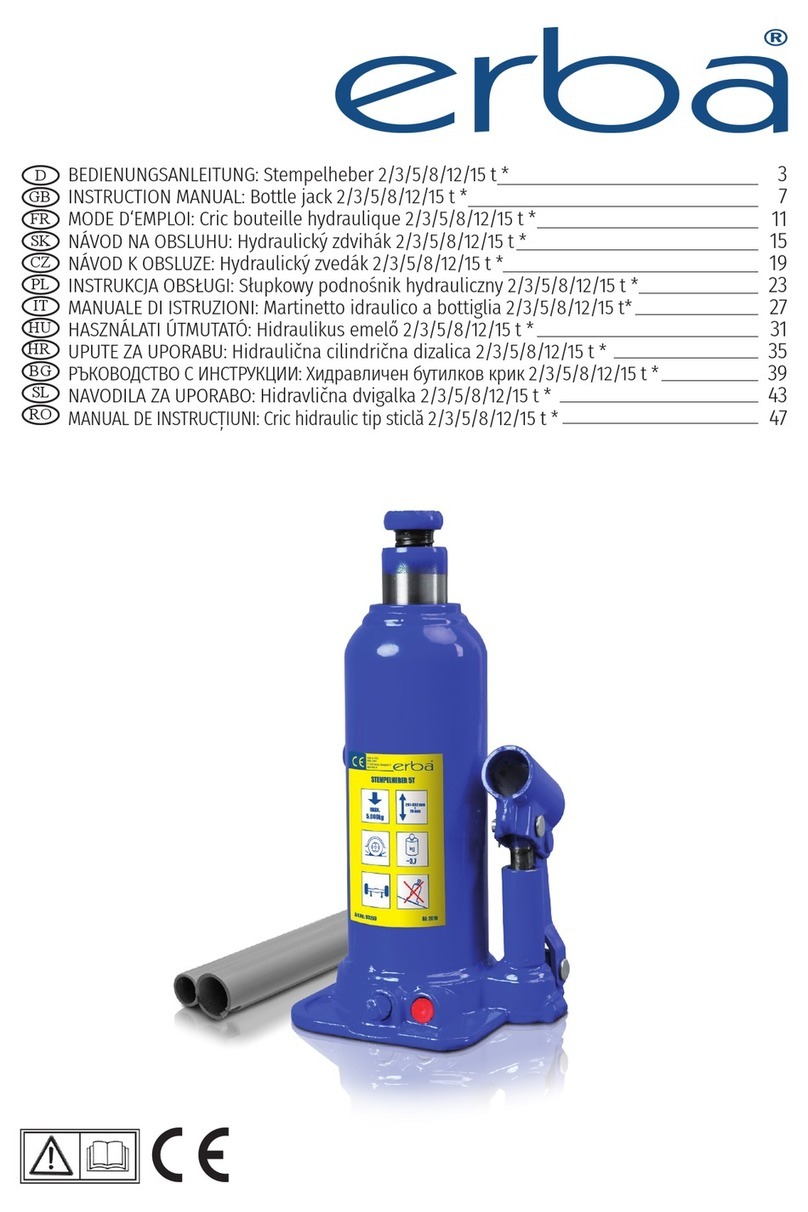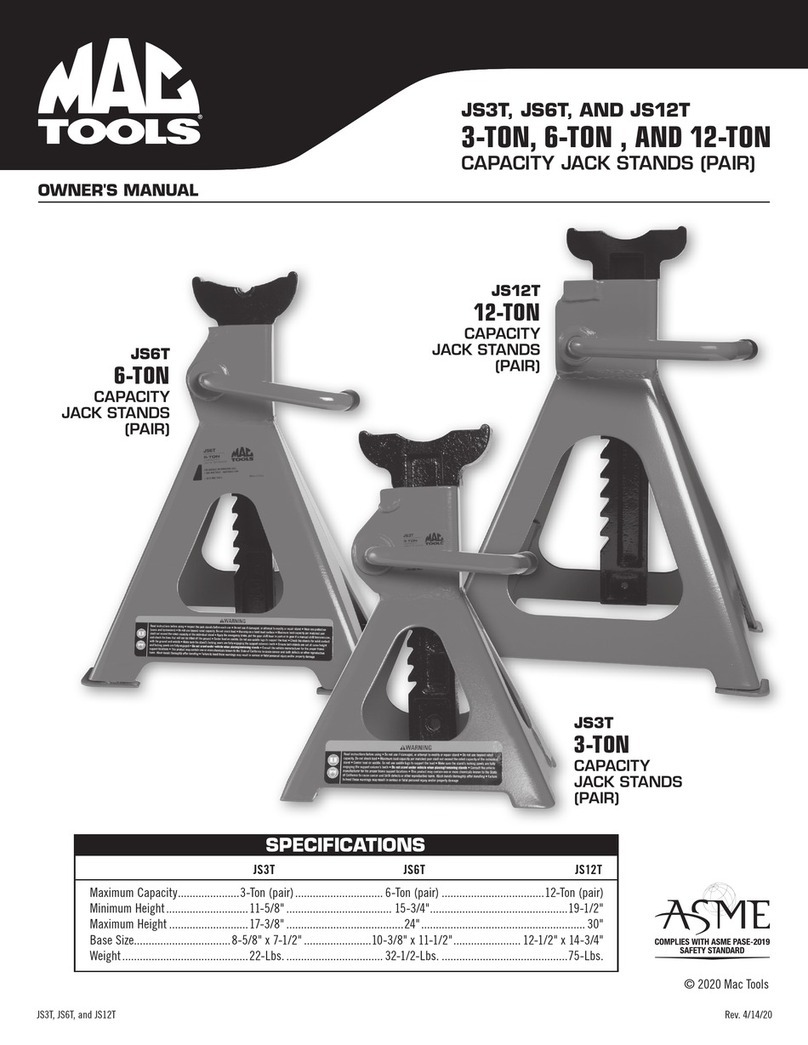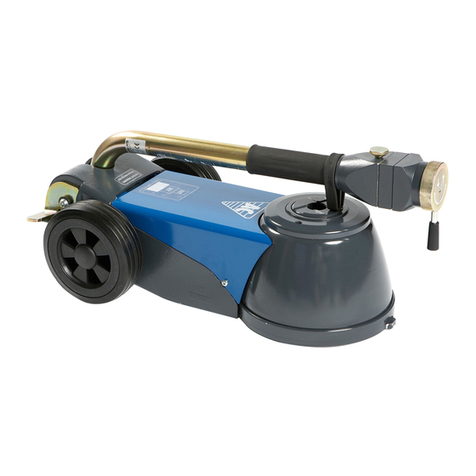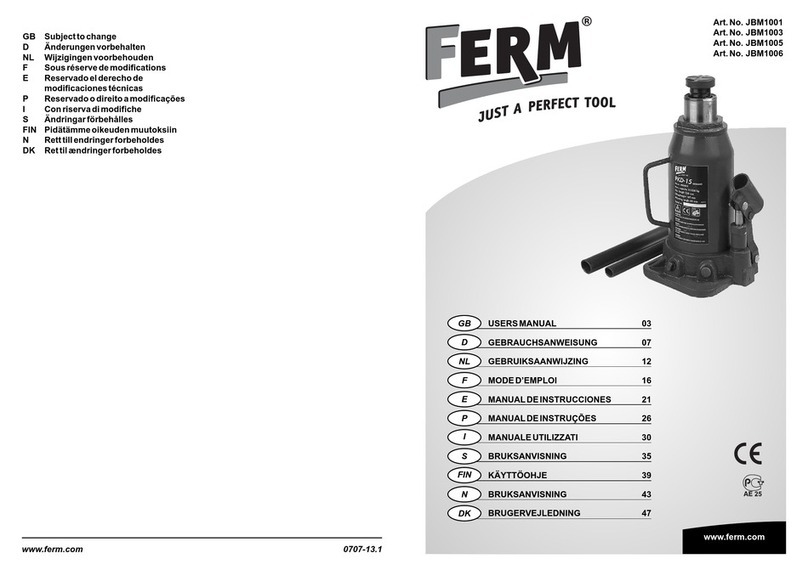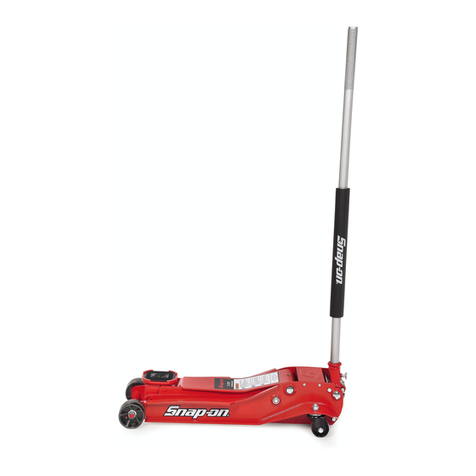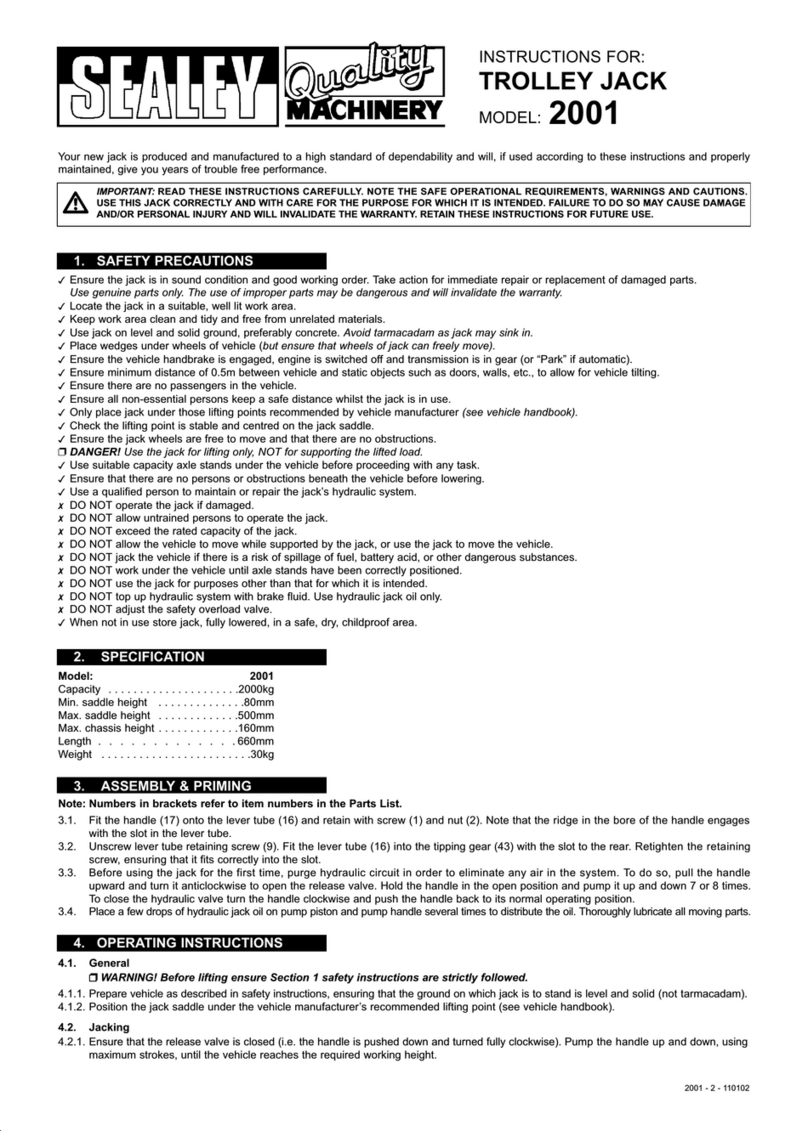ERBA 03088 User manual

BEDIENUNGSANLEITUNG: Hydraulik Wagenheber 3t *
INSTRUCTION MANUAL: Hydraulic jack 3t *
MODE D‘EMPLOI: Cric hydraulique à 3t *
NÁVOD NA OBSLUHU: Hydraulický zdvihák 3t *
NÁVOD K OBSLUZE: Hydraulický zvedák 3t *
INSTRUKCJA OBSŁUGI: Siłownik hydrauliczny 3t *
MANUALE DI ISTRUZIONI: Martinetto idraulico 3t *
HASZNÁLATI ÚTMUTATÓ: Hidraulikus emelő 3t *
UPUTE ZA UPORABU: Hidraulička dizalica 3t *
РЪКОВОДСТВО С ИНСТРУКЦИИ: Хидравличен крик 3t
*
NAVODILA ZA UPORABO: Hidravlična dvigalka 3t *
MANUAL DE INSTRUCȚIUNI: Cric hidraulic 3t *
3
10
17
24
31
38
45
52
59
66
73
80
D
GB
FR
SK
CZ
PL
IT
HU
HR
BG
SL
RO

* Technische Änderungen vorbehalten
* Technical changes reserved
* Sous réserve de modifications techniques
* Technické zmeny vyhradené
* Technické změny vyhrazeny
* Producent zastrzega sobie prawo do wprowadzania zmian technicznych
* Soggetto a modifiche tecniche
* A műszaki változtatások joga fenntartva
* Pridržavamo pravo na tehničke izmjene
* запазено е правото за технически промени
* Pravice do tehničnih sprememb pridržane
* Ne rezervăm dreptul de a efectua modificări tehnice
A B C D E
1
4
2
3
F

ERBA GmbH
A-1230 Wien
Talpagasse 6
Bedienungsanleitung
03088
Stand: 06/2018
Druck- und Satzfehler vorbehalten!
Seite 3
DE - BEDIENUNGSANLEITUNG
INHALT
1. Sicherheitshinweise
2. Produktbeschreibung
3. Bestimmungsgemäße Verwendung
4. Einsatzbeschränkungen
5. Technische Daten
6. Geräuschemissionswerte
7. Notwendige Informationen für die Inbetriebnahme
8. Bedienungshinweise / Fehlerbeschreibung
9. Service und Ersatzteile
10. Garantie
11. Entsorgung
12. Rechtliche Hinweise
13. Konformitätserklärung
Seite
4
5
5
5
5
5
5
6
8
8
8
8
9

ERBA GmbH
A-1230 Wien
Talpagasse 6
Bedienungsanleitung
03088
Stand: 06/2018
Druck- und Satzfehler vorbehalten!
Seite 4
DE - BEDIENUNGSANLEITUNG
Bitte lesen Sie vor der Inbetriebnahme des Gerätes zu Ihrer eigenen Sicherheit dieses Handbuch
und die allgemeinen Sicherheitshinweise gründlich durch. Wenn Sie das Gerät Dritten überlassen,
legen Sie diese Gebrauchsanleitung immer bei. Wir übernehmen keine Haftung für Unfälle oder
Schäden, die durch Nichtbeachtung dieser Anleitung und den Sicherheitshinweisen entstehen.
Wenn Sie Schutzvorrichtungen entfernen, verändern oder andere bauliche Verände-
rungen vornehmen entfällt jegliche Haftung des Herstellers!!
1. SICHERHEITSHINWEISE
Die gehobene Last darf niemals die angegebene Maximallast des Wagenhebers überschreiten.
Der maximal angegebene Hub des Wagenhebers darf nicht überschritten werden.
Verwenden Sie den Wagenheber nur auf ebenem, stabilem Untergrund und in gut beleuchteter
Umgebung. Verwenden Sie das Gerät nicht auf Böden, die einsinken oder durchbrechen können.
Stellen Sie sicher, dass sich in dem zu hebendem KFZ keine Personen befinden. Stellen Sie den
Motor ab und ziehen Sie die Handbremse. Vergewissern Sie sich, daß das KFZ nicht wegrollen
oder wegrutschen kann. Bei mechanischem Getriebe den 1. Gang oder den Rückwärtsgang ein-
legen. Bei automatischem Getriebe Stellung „P“.
Benutzen Sie Bremsklötze (A).
Steigen Sie niemals in das KFZ oder starten Sie dessen Motor während es sich auf dem Wagen-
heber befindet.
Der Wagenheber dient nur zum Heben von KFZ - versuchen Sie niemals die gehobene Last mit
dem Wagenheber zu bewegen.
Platzieren Sie den Wagenheber unter dem vom Hersteller des KFZ dafür vorgesehenen Punkt.
Vergewissern Sie sich, dass der Auflagepunkt am KFZ nicht rostig, schmutzig oder schmierig ist.
Achten Sie darauf, dass der Auflagepunkt des KFZ mittig auf der Hubfläche des Wagenhebers
aufliegt. Ist dies nicht der Fall, kann der Wagenheber kippen oder wegrutschen. Es besteht Ver-
letzungsgefahr!
Achten Sie darauf, dass sich das KFZ während des Hebevorganges nicht bewegen kann. Starker
Verkehr kann Vibrationen hervorrufen, wenn Sie den Wagenheber am Straßenrand benutzen. War-
ten Sie einen günstigen Moment ab.
Platzieren Sie den Wagenheber so,dass Sie wärend der Benutzung keine Körperteile unter das an-
zuhebende KFZ bringen müssen.Arbeiten Sie niemals unter einem KFZ, das nur vom Wagenheber
gehalten wird. Benutzen Sie unbedingt mechanische Stützen oder ähnliches (C). Halten Sie immer
genügend Sicherheitsabstand zu den beweglichen Teilen des Wagenhebers.
Behalten Sie während des Anhebens den Wagenheber immer im Blickfeld. Unterbrechen Sie un-
verzüglich den Arbeitsvorgang wenn sich gefährliche Situationen ergeben, wie zB. dass sich das
KFZ unvorhergesehen bewegt.
Vergewissern Sie sich, dass sich keine anderen Personen oder Gegenstände unter dem Fahrzeug
befinden, bevor Sie den Wagenheber senken.

ERBA GmbH
A-1230 Wien
Talpagasse 6
Bedienungsanleitung
03088
Stand: 06/2018
Druck- und Satzfehler vorbehalten!
Seite 5
DE - BEDIENUNGSANLEITUNG
2. PRODUKTBESCHREIBUNG
Der Wagenheber dient zum Anheben von KFZ bis maximal 3 t. Jede andere Verwendung ist nicht be-
stimmungsgemäß. Für alle Schäden/Verletzungen, die aus nicht bestimmungsgemäßer Verwendung
resultieren haftet der Benutzer des Gerätes, nicht jedoch der Hersteller/Händler.
3. BESTIMMUNGSGEMÄSSE VERWENDUNG
Der Wagenheber ist nur zu anheben von Lasten konzipiert. Jegliche horizontale Bewegung von
Lasten ist verboten. Nicht auf rutschigen, instabilen oder abfallenden Oberflächen verwenden. Bitte
beachten Sie, dass dieses Gerät bestimmungsgemäß nicht für den gewerblichen Einsatz konstruiert
wurde. Wir übernehmen keine Gewährleistung, wenn das Gerät in Gewerbe-, Handwerks- oder
Industriebetrieben sowie bei gleichzusetzenden Tätigkeiten eingesetzt wird.
4. EINSATZBESCHRÄNKUNGEN
5. TECHNISCHE DATEN
1 - Handgriff (2 Teile)
2 - Hubarm
3 - Hubfläche
4 - Aufnahme f. Handgriff
Maximallast:
Minimalhöhe:
Maximalhöhe:
Gewicht:
3t
130 mm
470 mm
28,8 kg
6. GERÄUSCHEMISSIONSWERTE
7. NOTWENDIGE INFORMATIONEN FÜR DIE INBETRIEBNAHME
Siehe Technische Daten.
Das Produkt wird in betriebsfertigem Zustand geliefert. Beachten Sie jedoch die Bedienungs- und
Wartungshinweise.

ERBA GmbH
A-1230 Wien
Talpagasse 6
Bedienungsanleitung
03088
Stand: 06/2018
Druck- und Satzfehler vorbehalten!
Seite 6
DE - BEDIENUNGSANLEITUNG
8. BEDIENUNGSHINWEISE / FEHLERBEHEBUNG
Bevor Sie den Wagenheber benutzen, gehen Sie wie folgt vor, um überschüssige Luft aus dem
Wagenheber abzulassen:
Stecken Sie den Handgriff (1) in die Halterung (4) und fixieren Sie ihn mit der dafür vorgesehenen
Schraube.
Drehen Sie den Handgriff im Uhrzeigersinn und Führen Sie in dieser Position ein paar Pumpbewe-
gungen durch. Dies sorgt für interne Schmierung und Entlüftung.
Achten Sie darauf, dass sich die Rollen des Wagenhebers frei drehen können.
Zum Anheben drehen Sie den Griff erst im Uhrzeigersinn und bewegen sie den Griff dann auf und ab.
Nutzen Sie die ganze Hubstrecke für ein zügiges Arbeiten (B).
Sichern Sie die gehobene Last zur Sicherheit immer mit Achsstützen (C).
Vor dem herablassen des KFZ, heben Sie es kurz an um die Stützen zu entfernen.
Vergewissern Sie sich, dass sich keine Personen oder Gegenstände unter dem KFZ befinden.
Drehen Sie nun den Griff entgegen dem Uhrzeigersinn um den Wagenheber zu senken.

ERBA GmbH
A-1230 Wien
Talpagasse 6
Bedienungsanleitung
03088
Stand: 06/2018
Druck- und Satzfehler vorbehalten!
Seite 7
DE - BEDIENUNGSANLEITUNG
Fehlerbehebung
Wagenheber hebt die Last nicht:
⇨Drehen Sie den Handgriff so weit wie möglich im Uhrzeigersinn
⇨Hydraulikölstand zu niedrig (siehe Service und Ersatzteile)
Wagenheber hält die Last nicht:
⇨Drehen Sie den Handgriff so weit wie möglich im Uhrzeigersinn
⇨Hydraulik ist ggf. verstopft. Drehen Sie den Handgriff gegen den Uhrzeigersinn. Stellen Sie sich
auf die Vorderräder des Wagenhebers und ziehen Sie den Hubarm manuell hoch. Lassen Sie
den Hubarm nun wieder absenken und überpfüfen Sie erneut die Funktionstüchtigkeit. Diesen
Prozees ggf. mehrfach wiederholen. Besteht das Problem weiterhin, wenden Sie sich an einen
Fachmann.
Hubarm hebt nicht bis zur max. Hubhöhe:
⇨Hydraulikölstand zu niedrig (siehe Service und Ersatzteile)
⇨Luft im System (siehe Bedienungshinweise)
Hubarm senkt nicht komplett ab:
⇨Hydraulik ist ggf. verstopft. Drehen Sie den Handgriff gegen den Uhrzeigersinn. Stellen Sie sich
auf die Vorderräder des Wagenhebers und ziehen Sie den Hubarm manuell hoch. Lassen Sie
den Hubarm nun wieder absenken und überpfüfen Sie erneut die Funktionstüchtigkeit. Diesen
Prozees ggf. mehrfach wiederholen. Besteht das Problem weiterhin, wenden Sie sich an einen
Fachmann.
⇨Rückzugsfedern gebrochen oder ausgeleiert
Hubarm hebt nicht flüssig:
⇨Luft im System (siehe Bedienungshinweise)

ERBA GmbH
A-1230 Wien
Talpagasse 6
Bedienungsanleitung
03088
Stand: 06/2018
Druck- und Satzfehler vorbehalten!
Seite 8
DE - BEDIENUNGSANLEITUNG
Alle Rechte vorbehalten. Dieses Handbuch ist urheberrechtlich geschützt. Vervielfältigung in me-
chanischer, elektronischer und jeder anderen Form ohne die schriftliche Genehmigung des Herstel-
lers ist verboten.
Das Produkt befindet sich in einer Verpackung um Transportschäden zu verhindern. Diese Ver-
packung ist Rohstoff und wiederverwendbar oder kann wieder dem Rohstoffkreislauf zugeführt
werden. Das Gerät und dessen Zubehör bestehen aus verschiedenen Materialien, wie z.B. Metalle,
Kunststoffe, Flüssigkeiten, Öle, etc. Führen Sie defekte Bauteile der Sondermüllentsorgung zu. Fra-
gen Sie im Fachgeschäft oder in der Gemeindeverwaltung nach.
12. RECHTLICHE HINWEISE
11. ENTSORGUNG
10. GEWÄHRLEISTUNG
Es gelten die gesetzlichen Gewährleistungsbestimmungen.
9. SERVICE UND ERSATZTEILE
Die Wartung und Instandhaltung des Wagenhebers ist nur von Personen vorzunehmen, die über
ausreichende Erfahrung im Umgang mit hydraulischen Systemen verfügen.
Halten Sie den Wagenheber sauber und sorgen Sie regelmässig für ausreichende Schmierung bei
allen beweglichen Teilen. Halten Sie diese sauber und geschützt.
Verwenden Sie nur original Ersatzteile.
Überprüfen Sie den Wagenheber vor jeder Anwendung auf lose, gebrochene oder verbogene Teile.
Besteht Verdacht, dass der Wagenheber überlastet wurde oder heftigen Stößen und Schlägen
ausgesetzt war, verwenden Sie ihn nicht bis alle notwendigen Schritte eingeleitet wurden um das
Problem zu beheben.
Um den Ölstand zu überprüfen, öffnen Sie bei völlig gesenktem Hebearm und auf ebenem
Untergrund den Ölstopfen (F). Der Ölstand sollte ca. 4 mm unter dem Rand der Öffnung sein.
Bei Nachfüllung nur Marken-Hydrauliköle verwenden. Niemals Bremsflüssigkeit verwenden!
Nach einem Jahr Verwendung sollte ein Ölwechsel vorgenommen werden, um eine lange
Lebensdauer des Hydrauliksystems zu gewährleisten.
Achten Sie darauf, dass kein Schmutz in das System gelangt.
Prüfen Sie den Wagenheber regelmäßig auf Anzeichen von Rost.
Säubern Sie das Gerät nach Notwendigkeit mit einem sauberen, geölten Tuch.
Nehmen Sie keine Veränderungen am Wagenheber vor!

ERBA GmbH
A-1230 Wien
Talpagasse 6
Bedienungsanleitung
03088
Stand: 06/2018
Druck- und Satzfehler vorbehalten!
Seite 9
DE - BEDIENUNGSANLEITUNG
KONFORMITÄTSERKLÄRUNG
DECLARATION OF CONFORMITY
Modelle/models:
03088 Hydraulischer Wagenheber 3t
ERBA GmbH, Talpagasse 6, 1230 Wien, erklärt hiermit dass das angeführte Modell den folgenden
CE Qualitätsstandards, Prüfungen und maßgeblichen Sicherheitsanforderungen entspricht:
Maschinenrichtline: 2006/42/EC
– EN 1494:2000/A1:2008
Wien, 01.06. 2015
For and on behalf of ERBA GmbH (authorized signature)
Dominik Schilling
Technischer Koordinator
ERBA GmbH, Talpagasse 6, 1230 Wien, Austria

ERBA GmbH
A-1230 Wien
Talpagasse 6
Instruction manual
03088
Issue: 06/2018
Changes, print, punctuation and other errors reserved!
Page 10
GB - INSTRUCTION MANUAL
Table of contents
1. Safety instructions
2. Product description
3. Designated use
4. Restrictions of use
5. Technical data
6. Noise emission values
7. Important information for initial operation
8. Operation instructions
9. Service and replacement parts
10. Warranty
11. Disposal
12. Legal information
13. Declaration of conformity
Page
11
12
12
12
12
12
12
13
15
15
15
15
16

ERBA GmbH
A-1230 Wien
Talpagasse 6
Instruction manual
03088
Issue: 06/2018
Changes, print, punctuation and other errors reserved!
Page 11
GB - INSTRUCTION MANUAL
Read this material before using this product. Failure to do so can result in serious injury. KEEP THIS
MANUAL. When giving this machine to third parties, always include this manual. We do not accept
any liabilities for accidents or damages that result from misuse. Removal/Alteration of any
safety devices or of the machine in general will result in the loss of warranty. The
buyer assumes all risk and liability arising out of his or her repairs/alterations to the
original product or replacement parts thereto, or arising out of his or her installation
of replacement parts thereto.
1. SAFETY INSTRUCTIONS
Never overload the hydraulic jack.
Never exceed the maximum lifting height of the hydraulic jack.
Make sure that the surface on which you use the hydraulic jack is level and stable. Never use the
hydraulic jack on surfaces that can cave in or collapse.
Always keep your work area well lit, clean and free of obstacles.
Never lift a vehicle when there are people inside. Stop the engine of the vehicle and pull the hand-
brake. Make sure that the vehicle can not roll or slip away. For vehilcles with manual transmission
use the 1st gear or the reverse gear. For vehicles with automatic transmission use positon „P“.
Always use chock blocks (A).
Never board the vehicle and/or start its engine as long as it is suspended on the hydraulic jack or
on support stands.
The hydraulic jack is desinged to lift automobiles or similar vehicles. It is not designed to move any
load horizontally. Never attempt to push a vehicle that is suspended on the hydraulic jack.
Position the hydraulic jack so that it will lift the vehicle using the designated supporting points as
indicated by tha manufacurer of the vehicle. Make sure that those points are not rusty, dirty, oily or
compromised in any other way.
Make sure that the lifting surface of the hydraulic jack is positioned in the center of the supporting
points on the vehicle. Failure to do so can result in the hydraulic jack tipping over and potentially
serious injuy or even death!
Make sure the vehicle can not move in any way when trying to lift it with the hydraulic jack. Heavy
traffic (when using the hydraulic jack near or on a road) may cause significant vibrations - wait for
the right timig if necessary.
Positon the hydraulic jack so that you do not have to put any part of your body below the vehicle
when lifting it.
Never crawl under a vehicle that is being lifted by a hydraulic jack. You MUST use a minimum of 2
support stands per axle (C) and make sure that the vehicle rests safely on those stands before you
can crawl under the vehicle and make repairs!
Pay close attention to the hydraulic jack while lifting. Immediately stop lifting the vehicle if you
notice anything unusual (eg. unstable jack, moving vehicle, etc).
Make sure that there are no objects or persons under the vehicle before you lower it.

ERBA GmbH
A-1230 Wien
Talpagasse 6
Instruction manual
03088
Issue: 06/2018
Changes, print, punctuation and other errors reserved!
Page 12
GB - INSTRUCTION MANUAL
2. PRODUCT DESCRIPTION
The hydraulic jack is designed to lift automobiles/vehicles up to a maximum weight of 3 t (see technical
data). Any other use is prohbited. The buyer accepts all liabilities, legal and otherwise, for any da-
mage or injury resulting from improper use of the product (i.e. any other use than the above stated
designated use).
3. DESIGNATED USE
The hydraulic jack is designed for lifting only. No horizontal movement of any load is allowed.
Do not use on unstable, slippery or inclined surfaces. Please note, that this product is not designed
for commercial or industrial use. We accept no liability or warranty claims should the product be
used in industrial and/or commercial operations.
4. RESTRICTIONS
5. TECHNICAL DATA
1 - Handle (2 parts)
2 - Lifting arm
3 - Lifting surface
4 - Socket for handle
Max.load capacity:
Min. lifting height:
Max. lifting height:
Weight:
3t
130 mm
470 mm
28,8 kg
6. NOISE EMISSION VALUES
7. IMPORTANT INFORMATION FOR INITIAL OPERATION
See technical data.
See operation instructions.

ERBA GmbH
A-1230 Wien
Talpagasse 6
Instruction manual
03088
Issue: 06/2018
Changes, print, punctuation and other errors reserved!
Page 13
GB - INSTRUCTION MANUAL
8. OPERATION INSTRUCTIONS
Before using the hydraulic jack you have to vent any excess air that may be trapped in the hydraluc
system (perform this every time you use this product):
Put the handle (1) in the socket (4) and tighten it with the screw that is on the back of the socket.
Turn the handle counterclockwise and execute a few pumping motions (moving the handle up
and down). This action should lubricate and ventilate the hydraulic jack.
Make sure the wheels of the hydraulic jack are not jammed. They should be able to move freely.
To lift the hydralic arm of the jack turn the handle clockwise and execute pumping motions.
Use all the available range of the handle for a quick and effective lifting motion (B).
Always use support stands to secure the vehicle (C).
After you finished the repairs on the vehicle, lift the vehicle slightly so that you can remove the
support stands.
Make sure there are no persons under the vehicle before you lower it
Turn the handle counterclockwise to lower the hydraulic arm of the jack.

ERBA GmbH
A-1230 Wien
Talpagasse 6
Instruction manual
03088
Issue: 06/2018
Changes, print, punctuation and other errors reserved!
Page 14
GB - INSTRUCTION MANUAL
Troubleshooting
Hydraulic jack does not lift:
⇨Check if the handle is turned all the way clockwise.
⇨Hydraulic oil level is too low (see service and replacement parts)
Hydraulic jack cannot hold the load:
⇨Check if the handle is turned all the way clockwise.
⇨Hydraulic system may be clogged/dirty. Turn the handle counterclockwise. Step on one of the
front wheels of the hydraulic jack and pull up the hydraulic arm manually. Lower the hydraulic
arm again and check. Repeat this process several times. If this does not help, contact a service
technician.
Hydraulic arm does not lift to its maximum lifting height:
⇨Hydraulic oil level is too low (see service and replacement parts)
⇨Air may be trapped in the system. Remove the air as described under „Operation instructions“
Hydraulic arm does not lower completely:
⇨Hydraulic system may be clogged/dirty. Turn the handle counterclockwise. Step on one of the
front wheels of the hydraulic jack and pull up the hydraulic arm manually. Lower the hydraulic
arm again and check. Repeat this process several times. If this does not help, contact a service
technician.
⇨Pullback-springs may be broken/loose/worn out.
Hydraulic jack does not lift smoothly:
⇨Air may be trapped in the system. Remove the air as described under „Operation instructions“

ERBA GmbH
A-1230 Wien
Talpagasse 6
Instruction manual
03088
Issue: 06/2018
Changes, print, punctuation and other errors reserved!
Page 15
GB - INSTRUCTION MANUAL
9. SERVICE AND REPLACEMENT PARTS
All rights reserved. This manual is copyrighted. Reproduction in and form (digital, print, etc.) is
strictly prohibited without the written permission of ERBA GmbH.
Our products are packed in order to prevent damage during transport. Packing materials are va-
luable resurces and therefore can and should be recycled. The product itself consists of various
materials (metals, oils, plastic, etc.) and should be disposed with care and in accordance with your
federal and local disposal regulations.
12. LEGAL INFORMATION
11. DISPOSAL
Legal warranty regulations apply.
10. WARRANTY
Servicing and repairing the hydraulic jack must only be done by authorized professionals.
Keep the hydraulic jack clean and its moving parts well lubricated.
Use only original spare parts.
Inspect the hydraulic jack before each usage. If you notice any damage or leakage, do not use it.
If you have reason to believe that the hydraulic jack has been overloaded or subjected to heavy
impacts, do not use it untill the necessary steps to fix the product have been undertaken.
To check the level of the hydraulic fluid, lower the hydraulic arm completely and put the handle
in its lowest position. Remove the rubber cap (F). The level of the hydraulic fluid should be about
4mm below the opening. Use suitable hydraulic oil only - never use brake-fluid!
Change the hydraulic fluid after about a year of regular usage.
Whenever checking or replacing the hydraulic fluid make sure that no dirt falls into the opening hole.
Check the hydraulic jack for rust on a regular basis. Clean the product with a clean cloth and a
little bit of oil.
Do not modify the hydraulic jack!

ERBA GmbH
A-1230 Wien
Talpagasse 6
Instruction manual
03088
Issue: 06/2018
Changes, print, punctuation and other errors reserved!
Page 16
GB - INSTRUCTION MANUAL
DECLARATION OF CONFORMITY
Models:
03088 Hydraulic jack 3t
ERBA GmbH, Talpagasse 6, 1230 Wien, hereby states, that the mentioned model meet the
following CE/RoHS quality standards, approvals and relevant safety requirements:
Machinery Directive: 2006/42/EC
– EN 1494:2000/A1:2008
Vienna, 01.06.2015
For and on behalf of ERBA GmbH (authorized signature)
Dominik Schilling
Technical coordinator
ERBA GmbH, Talpagasse 6, 1230 Wien, Austria

ERBA GmbH
A-1230 Wien
Talpagasse 6
MODE D‘EMPLOI
03088
Édition: 06/2018
Sous réserve de modifications, différences!
Page 17
FR - MODE D‘EMPLOI
Table des matières
1. Consignes de sécurité
2. Description du produit
3. Usage conforme
4. Restrictions d‘utilisation
5. Données techniques
6. Valeurs d‘émissions sonores
7. Informations importantes pour la première utilisation
8. Utilisation
9. Entretien/pièces de rechange
10. Garantie
11. Mise au rebut
12. Mentions légales
13. Déclaration de Conformité
Recherche
18
19
19
19
19
19
19
20
22
22
22
22
23

ERBA GmbH
A-1230 Wien
Talpagasse 6
MODE D‘EMPLOI
03088
Édition: 06/2018
Sous réserve de modifications, différences!
Page 18
FR - MODE D‘EMPLOI
Lisez ce document avant d‘utiliser le produit. Faute de quoi, vous vous exposez à un risque de graves blessures
corporelles. GARDEZ CE MODE D‘EMPLOI Si vous donnez cette machine à une autre personne, donnez-lui
impérativement ce mode d‘emploi. Nous déclinons toute responsabilité pour les dommages ou accidents
résultant d‘une utilisation non conforme. L‘enlèvement/altération d‘un des dispositifs de sécurité ou de la
machine dans son ensemble entraîne la perte de la garantie. L‘acheteur assume la totalité des risques
et responsabilités découlant de ses réparations/altérations du produit original ou de ses pièces de
rechange, ou découlant de son installation des pièces de rechange.
1. CONSIGNES DE SÉCURITÉ
Ne surchargez jamais un cric hydraulique.
Ne dépassez jamais la hauteur de levage maximale du cric hydraulique.
Veillez à ce que la surface sur laquelle vous utilisez le cric hydraulique est à niveau et stable. N’utilisez jamais un
cric hydraulique sur des surfaces qui peuvent céder ou s’effondrer.
Faites en sorte que l’aire de travail reste toujours propre, dégagée et bien éclairée.
Ne soulevez jamais un véhicule dans lequel il y a des personnes. Arrêtez le moteur du véhicule et tirez le frein
à main. Assurez-vous que le véhicule ne puisse pas rouler ou glisser. Pour les véhicules avec une transmission
manuelle, utilisez la 1ère vitesse ou la marche arrière. Pour les véhicules avec une transmission automatique,
utilisez la position « P ».
Utilisez toujours des blocs de calage (A).
Ne montez jamais dans le véhicule et/ou ne démarrez jamais le moteur tant qu’il est suspendu sur le cric hyd-
raulique ou sur des supports.
Le cric hydraulique est conçu pour soulever des voitures ou des véhicules similaires. Il n’est pas conçu pour déplacer
des charges horizontalement. N’essayez jamais de pousser un véhicule qui est suspendu sur un cric hydraulique.
Placez le cric hydraulique de sorte qu’il soulève le véhicule en utilisant les points de support dédiés comme
indiqué par le constructeur du véhicule. Veillez à ce que ces points ne soient pas rouillés, sales ou compromis
de toute autre manière.
Veillez à ce que la surface de levage du cric hydraulique soit placée au centre des points de support du véhicule.
Le non-respect de cette consigne peut provoquer une inclinaison du cric hydraulique et des blessures potenti-
ellement graves ou même la mort !
Assurez-vous que le véhicule ne peut pas bouger lorsque vous essayez de le soulever avec le cric hydraulique.
Une circulation importante (lorsque vous utilisez le cric hydraulique près ou sur une route) peut provoquer des
vibrations significatives. Attendez le bon moment si nécessaire.
Placez le cric hydraulique de sorte à ne pas avoir à poser des parties de votre corps en dessous du véhicule
lorsque vous le soulevez.
Ne rampez jamais sous un véhicule qui est soulevé par un cric hydraulique. Vous DEVEZ utiliser au minimum
2 supports par essieu (C) et vous assurer que le véhicule repose en toute sécurité sur ces supports avant de
ramper sous le véhicule et faire les réparations !
Faites très attention au cric hydraulique quand vous soulevez un véhicule.Arrêtez immédiatement de soulever le vé-
hicule si vous remarquez quelque chose d’anormal (par exemple un cric instable, un déplacement du véhicule,etc.).
Assurez-vous qu’il n’y a pas d’objets ou de personnes sous le véhicule avant de l’abaisser.

ERBA GmbH
A-1230 Wien
Talpagasse 6
MODE D‘EMPLOI
03088
Édition: 06/2018
Sous réserve de modifications, différences!
Page 19
FR - MODE D‘EMPLOI
2. DESCRIPTION DU PRODUIT
1 - Poignée (2 pièces)
2 - Bras de levage
3 - Surface de levage
4 - Fixation pour poignée
Le cric hydraulique est conçu pour soulever des voitures/véhicules dont le poids maximum est de 3t
(voir données techniques). Tout autre type d’utilisation est à proscrire. L‘acheteur assume l‘ensemble
des responsabilités, légales ou autres, pour les éventuels dommages ou blessures résultant d‘une
utilisation incorrecte de l‘appareil (c.à.d. toute utilisation non conforme, voir ci-dessus).
3. USAGE CONFORME
Le cric hydraulique est conçu uniquement pour soulever. Aucun mouvement horizontal de toute
charge n’est permis. N’utilisez pas de surfaces instables, glissantes ou inclinées. Veuillez noter que
ce produit n‘a pas été conçu pour être utilisé dans un environnement industriel ou commercial.
Nous déclinons toute responsabilité et toute garantie à partir du moment où l‘appareil est utilisé
dans un environnement industriel et/ou commercial.
4. RESTRICTIONS
5. DONNÉES TECHNIQUES
Capacité de charge max. :
Hauteur de levage min. :
Hauteur de levage max. :
Poids :
3t
130 mm
470 mm
28,8 kg
6. VALEURS D‘ÉMISSIONS SONORES
7. INFORMATIONS IMPORTANTES POUR LA PREMIÈRE UTILISATION
Voir données techniques.
Voir Utilisation.

ERBA GmbH
A-1230 Wien
Talpagasse 6
MODE D‘EMPLOI
03088
Édition: 06/2018
Sous réserve de modifications, différences!
Page 20
FR - MODE D‘EMPLOI
8. UTILISATION
Avant d’utiliser le cric hydraulique, vous devez évacuer tout excès d’air qui pourrait être piégé dans
le système hydraulique (effectuez cette opération à chaque fois que vous utilisez ce produit) :
Mettez la poignée (1) dans la fixation (4) et serrez-la avec la vis qui se trouve au dos de la fixation.
Tournez la poignée dans le sens inverse des aiguilles d’une montre et effectuez quelques mou-
vements de pompage (déplacez la poignée vers le haut et vers le bas). Cette action doit lubrifier
et ventiler le cric hydraulique.
Veillez à ce que les roues du cric hydraulique ne soient pas bloquées.
Elles doivent pouvoir bouger librement.
Pour soulever le bras hydraulique du cric, tournez la poignée dans le sens des aiguilles d‘une mon-
tre et effectuez des mouvements de pompage.
Utilisez toute la portée disponible de la poignée pour avoir un mouvement de levage rapide et
efficace (B).
Utilisez toujours les supports pour sécuriser le véhicule (C).
Après avoir fini les réparations sur le véhicule, levez légèrement le véhicule afin de pouvoir enlever
les supports.
Assurez-vous qu’il n’y ait personne sous le véhicule avant de l’abaisser.
Tournez la poignée dans le sens inverse des aiguilles d’une montre pour abaisser le bras hydrau-
lique du cric.
Table of contents
Languages:
Other ERBA Jack manuals
Popular Jack manuals by other brands
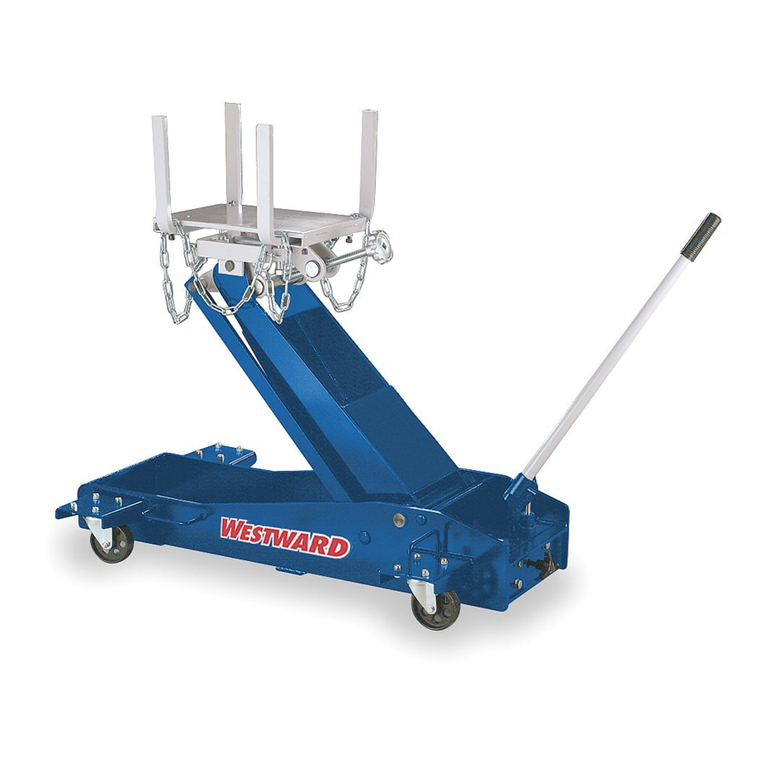
Westward
Westward 1VW35 Operating instructions & parts manual
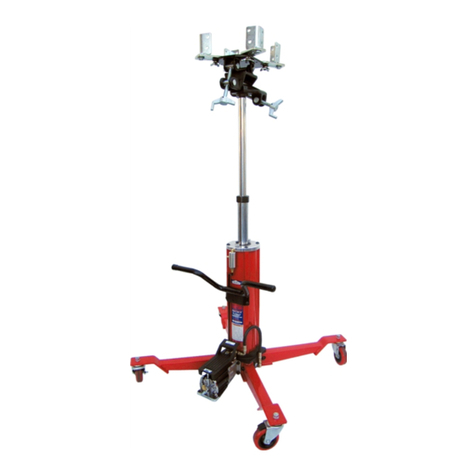
Norco
Norco 72450A Setup, operating, maintenance instructions

RHINOMOTIVE
RHINOMOTIVE HYDRAULIC CROCODILE R3101 user manual
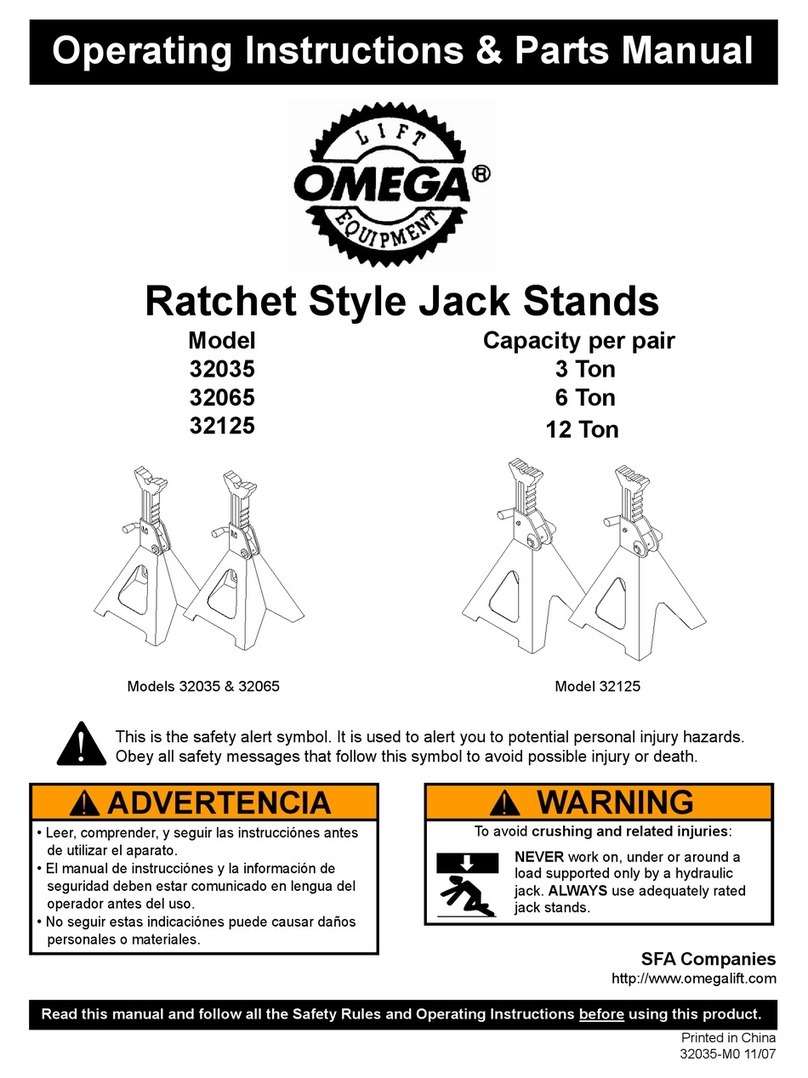
Omega
Omega 32035 Operating instructions & parts manual
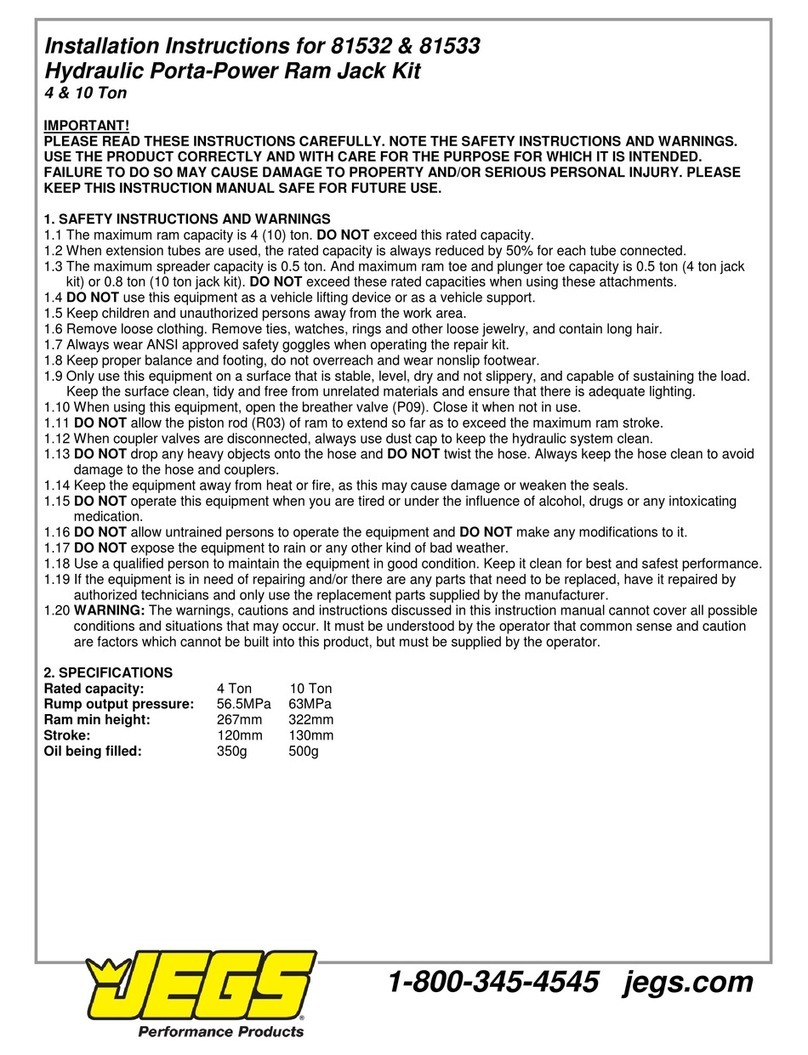
Jegs
Jegs 81532 installation instructions

NU-LIFT
NU-LIFT HFJ-700 instruction manual
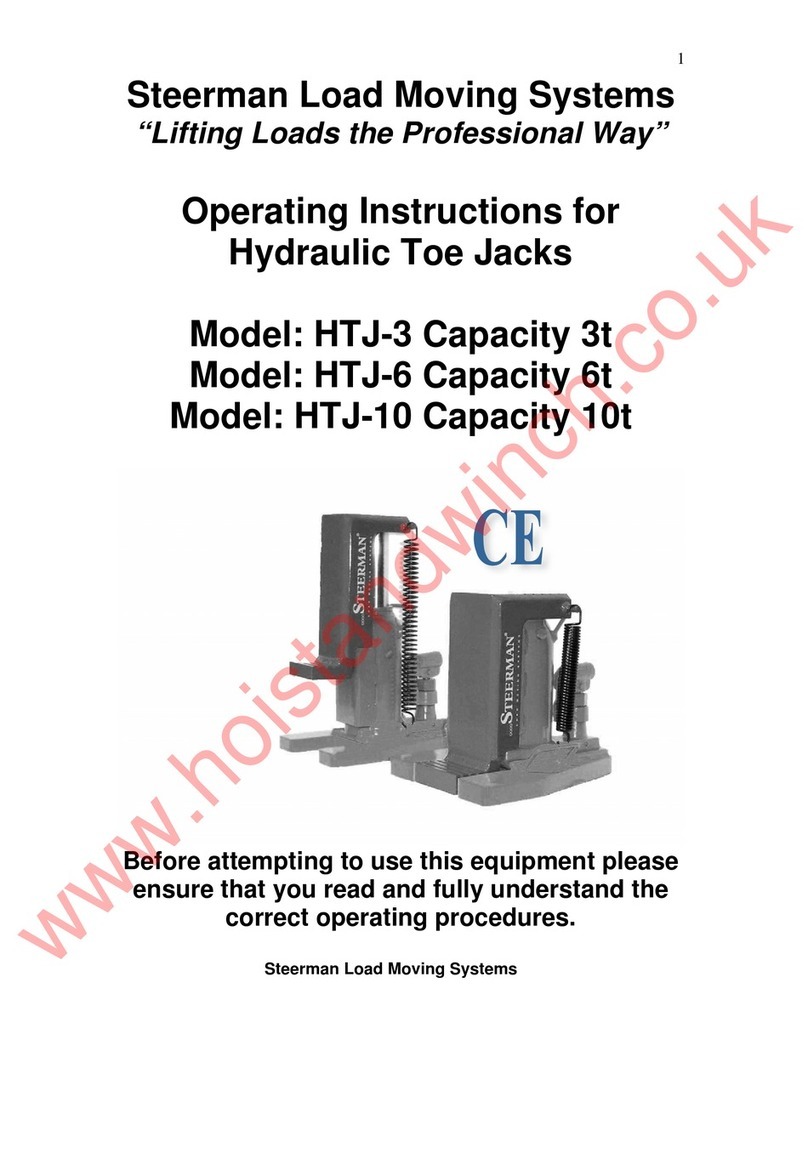
Steerman Load Moving Systems
Steerman Load Moving Systems HTJ-3 operating instructions
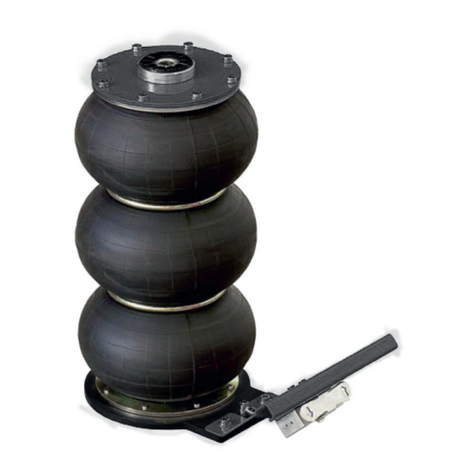
CLAS
CLAS OP 0307 manual
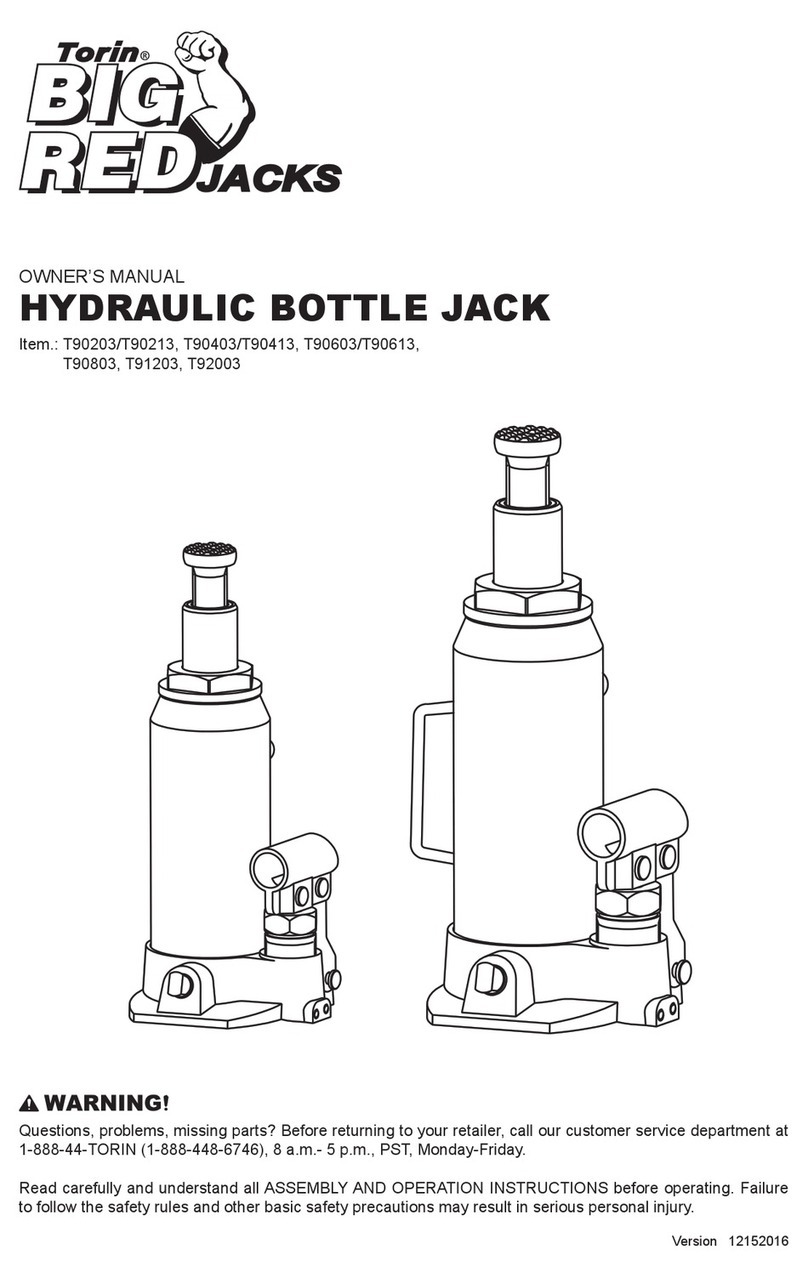
BIG RED JACKS
BIG RED JACKS T90203 owner's manual
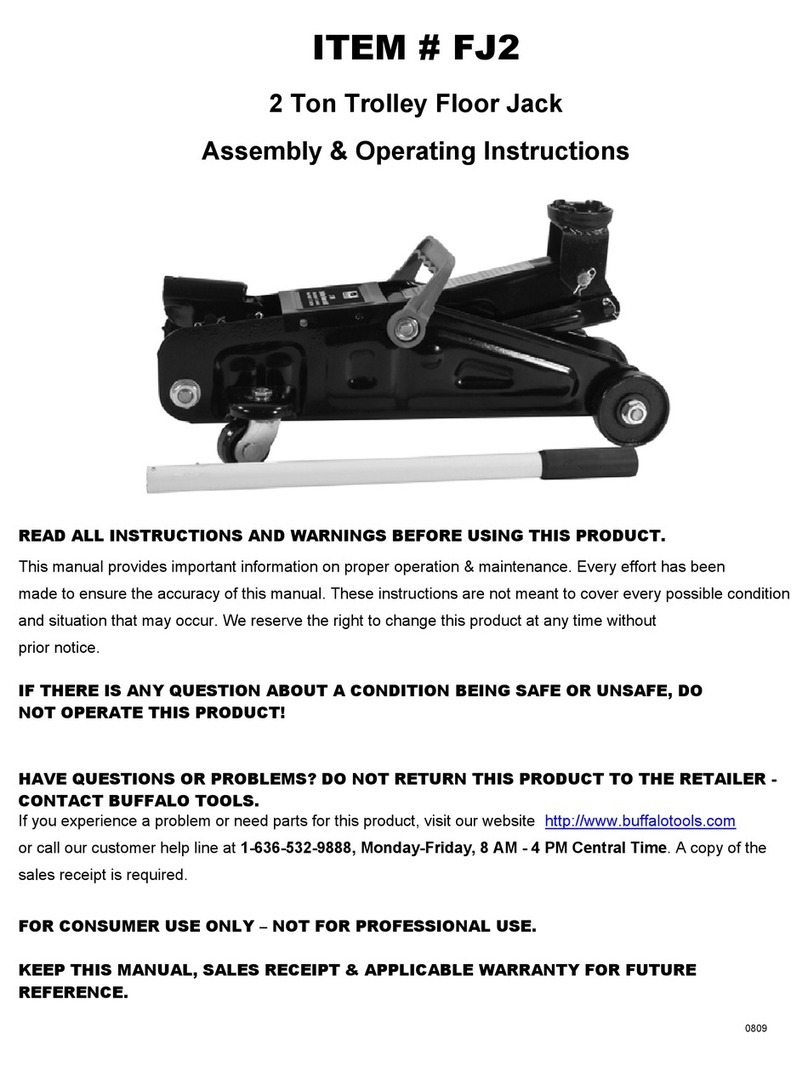
Buffalo Tools
Buffalo Tools FJ2 Assembly & operating instructions

Haklift
Haklift TUNKHA15AL Original instructions

Craftsman
Craftsman 48181 Operator's manual
